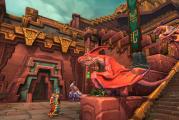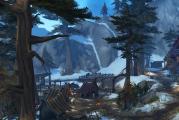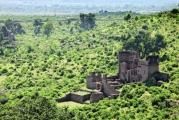Worksheet the eternal city and its inhabitants. "eternal city" and its inhabitants
The city of Rome is celebrating its 2766th anniversary this year. The history of the city is its monuments, striking in their grandiosity and scope at all times. It is no coincidence that the city of Rome is called the Eternal. In today's lesson, we will take an unusual tour of ancient city, plunge into the atmosphere of Imperial Rome.
background
In II AD The Roman Empire reached its peak (see lesson). The center of a vast empire was the city of Rome. From it, 372 stone-paved roads led to all parts of the empire (province), and signs indicating the distance to Rome appeared every thousand steps. Rome and its main buildings, such as the Pantheon, were designed to embody the idea of the power and greatness of the empire.
Events
Main buildings in Ancient Rome
During this period, more than a million people lived in Rome. Thousands of inhabitants from Italy and the provinces sought daily to get to Rome. Some came on trade matters, others wanted to get a profitable position in the service of the emperor. Someone came to watch the gladiatorial games in the Colosseum (Flavian Amphitheatre), which could accommodate about 50 thousand people, or the chariot races in the Circus Maximus.
The main attraction of Rome was the Pantheon (the temple of all the gods). The Pantheon is crowned with a half-ball dome. The temple is built of brick and concrete, lined with marble inside (Fig. 1).
The central square of Rome was the Forum (Fig. 2). Here was the temple of Saturn, the temple of the keeper of the hearth of Vesta, the Milliarium column (from which the distance was measured not only in Rome, but also outside it), the buildings of the curia were located, in which the Senate met and court proceedings were held.

Rice. 2. Roman Forum ()
Each emperor sought to build his own forum. So the Forum of Caesar, the Forum of Augustus, the Forum of Trajan and others appeared in Rome.
The Romans loved to visit the theatre. The first permanent stone theater was built around 55 BC. e. commander Gnaeus Pompey the Great. The theater of Marcellus was built in 12 BC. e. and seated 11,000 spectators. The actors used masks and colorful clothes so that the audience understood who was in front of them - an old man or a young maiden. All roles in the Roman theater were played by men. Theatrical craft was considered an unworthy occupation.
One of the most visited public institutions Rome had baths - terms (Fig. 3). In total, there were more than a thousand public baths in Rome. The largest and most luxuriously decorated baths were built at the behest of Emperor Trajan. Here the Romans came to relax and enjoy a pleasant conversation, sports grounds, swimming pools and libraries were also located here.

Rice. 3. Roman terms ()
Rome was largest city empire, it was called the eternal, golden, or simply - the City.
Bibliography
- A.A. Vigasin, G.I. Goder, I.S. Sventsitskaya. Ancient world history. Grade 5 - M.: Education, 2006.
- Nemirovsky A.I. History Reading Book ancient world. - M.: Enlightenment, 1991.
- Ancient Rome. Book for reading / Ed. D.P. Kallistova, S.L. Utchenko. - M.: Uchpedgiz, 1953.
- Dictionary.yandex.ru ().
- Dic.academic.ru ().
- Theater.helllab.ru ().
Homework
- What public places were the most popular among the Romans?
- What public spectacles were held at the Circus Maximus?
- What public institutions were located at the Forum?
- Why did the Romans visit the baths?
1 slide
In the 2nd c. farmers were transferred to Rome CHOOSE THE CORRECT ANSWER. Trajan condemned Trojan conquered the Romans invented on rent on free lands In the province of Criminals Scammers Bribers Cement Concrete Whitewash. Dacia Parthia Syria

2 slide

3 slide
LESSON PLAN. 1. ROME - "HEART" OF THE EMPIRE. 2. CITY BUILDINGS. 3. PUBLIC BATH. 4. "BREAD AND SPEACHES".

4 slide
TASK FOR THE LESSON? People from all the Roman provinces tried to move to Rome. What do you think attracted them to The eternal City» ?

5 slide
1. ROME - "HEART" OF THE EMPIRE. In Rome there was a huge number of buildings designed to emphasize the power of the empire. Triumphal arches were erected in many forums of the city in honor of victories over enemies Triumphal Arch

6 slide
1. ROME - "HEART" OF THE EMPIRE. To glorify the emperors, columns were built in many Forums. Bas-reliefs with scenes from the life of emperors were placed on the column itself, and multi-meter statues of emperors crowned the columns.

7 slide
1. ROME - "HEART" OF THE EMPIRE. The building of the Colosseum, intended for organizing spectacles and holding performances, has become the symbol of the city. It accommodated about 50 thousand spectators of the Colosseum in Rome.

8 slide
The Pantheon is the temple of all gods. Daylight. D-8.5 m. Niches. Lightened the dome. The height of the dome is 43 m. The walls are lined with marble. The bricks of the dome were held together with pumice cement.

9 slide
Domus-dwelling of a rich Roman Cabinet. Living rooms. Sloping roof - Atria. Atrium-heated guest room. Leased premises Canteen-triclinium.

10 slide
Insula-city buildings. Public toilets. Taverns. Rooms for nobility. The rooms of the rich. Poor rooms. Garbage and slops were thrown into the street

11 slide
2. CITY BUILDINGS. In cold weather, houses were heated. The Romans were the first to come up with a central heating system. During construction, special fireplaces were installed on the lower floor. Warm air heated the floor and pipes specially made in the walls of the building. The heated stone retained heat for a very long time.

12 slide
3. PUBLIC BATH. In the 3rd century, there were 1000 private and 11 public baths in Rome. One of the most beautiful buildings The cities were considered THERMES (baths) of the emperor Caracalla. Baths of Caracalla.

CHOOSE THE CORRECT ANSWER.
In the 2nd c. translated in Rome
farmers
For Rent
To free lands
In the province
Trajan condemned
criminals
informers
bribe takers
Trojan conquered
Dacia
Parthia
Syria
The Romans invented
Cement
Concrete
Whitewash.
"ETERNAL CITY" AND ITS RESIDENTS
LESSON PLAN.
1. ROME - "HEART" OF THE EMPIRE.2. CITY BUILDINGS.
3. PUBLIC BATH.
4. "BREAD AND SPEACHES".
TASK FOR THE LESSON
? Tried to move to Romeinhabitants from all the Roman provinces.
What do you think attracted them to
"The eternal City" ?
1. ROME - "HEART" OF THE EMPIRE.
In Rome there were a huge number of buildings designed to emphasize the power of the empire.In many forums of the city
have been established
triumphal arches in
honor of victories over enemies
Triumphal Arch
1. ROME - "HEART" OF THE EMPIRE.
For glorificationemperors for many
Forums were built
columns.
On the column itself
placed
bas-reliefs with scenes
the lives of emperors
crowned columns
multimeter statues
emperors.
1. ROME - "HEART" OF THE EMPIRE.
Coliseumin Rome.
The building of the Colosseum, intended for organizing spectacles and performances, has become the symbol of the city.
It accommodated about 50 thousand spectators
The Pantheon is the temple of all gods.
dome bricksheld together with cement
pumice stone
D-8.5 m.
Niches.
Lightened the dome.
natural
Lighting.
Height
domes-43 m.
Walls
lined
marble.
Domus - home of a wealthy Roman
Atrium-heatedguest room.
Rented
premises
sloping
roofAtria.
Residential
rooms.
Cabinet.
Dining room triclinium.
Insula-city buildings.
Roomsthe poor.
The rooms of the rich.
Public
toilets.
Taverns.
Garbage and slop
thrown away
to the street
Rooms for
know.
2. CITY BUILDINGS.
In cold weather, houses were heated. The Romans warm air heated the floor and pipes on purposeyou invented the central heating system.
made in the walls of the building.
During construction on the ground floor
heated
the stone is very
kept for a long time
warmly.
established
special
fireplaces.
3. PUBLIC BATH.
In the 3rd century in Rome there were 1000 private and 11public baths. One of the most beautiful
buildings of the city were considered THERMAS (baths) of the emperor
Caracalla.
Thermae
Caracalla.
3. PUBLIC BATH.
At the entrance there were changing rooms withchambers for storing clothes.
3. PUBLIC BATH.
In one of the rooms withhigh temperature,
a swimming pool was built. AT
this damp atmosphere
visitors soared and
sweat.
Caldarium-warm pool.
3. PUBLIC BATH.
In one of the hallswas big
swimming pool with cool
water to
visitors could
cool down after
steam room visits.
Frigidarium pool
with cool water.
4. "BREAD AND SPEACHES".
Chariot racing.The growth of the power of the empire
led to that
the poor inhabitants of Rome
wanted to work.
They demanded from the state the free distribution of bread and devices
mass spectacles.
The most favorite spectacle was the chariot race, which gathered dozens of
thousand spectators.
slide 2
"ETERNAL CITY" AND ITS RESIDENTS
slide 3
LESSON PLAN.
1. ROME - "HEART" OF THE EMPIRE. 2. CITY BUILDINGS. 3. PUBLIC BATH. 4. "BREAD AND SPEACHES".
slide 4
TASK FOR THE LESSON
People from all the Roman provinces tried to move to Rome. What do you think attracted them to the "Eternal City"?
slide 5
1. ROME - "HEART" OF THE EMPIRE.
In Rome there was a huge number of buildings designed to emphasize the power of the empire. Triumphal arches were erected in many forums of the city in honor of victories over enemies Triumphal Arch
slide 6
To glorify the emperors, columns were built in many Forums. Bas-reliefs with scenes from the life of emperors were placed on the column itself, and multi-meter statues of emperors crowned the columns.
Slide 7
The building of the Colosseum, intended for organizing spectacles and holding performances, has become the symbol of the city. It accommodated about 50 thousand spectators of the Colosseum in Rome.
Slide 8
The Pantheon is the temple of all gods.
Daylight. D-8.5 m. Niches. Lightened the dome. The height of the dome is 43 m. The walls are lined with marble. The bricks of the dome were held together with pumice cement.
Slide 9
Domus - home of a wealthy Roman
Cabinet. Living rooms. Sloping roof - Atria. Atrium-heated guest room. Leased premises Canteen-triclinium.
Slide 10
Insula-city buildings.
Public toilets. Taverns. Rooms for nobility. The rooms of the rich. Poor rooms. Garbage and slops were thrown into the street
slide 11
2. CITY BUILDINGS.
In cold weather, houses were heated. The Romans were the first to come up with a central heating system. During construction, special fireplaces were installed on the lower floor. Warm air heated the floor and pipes specially made in the walls of the building. The heated stone retained heat for a very long time.
slide 12
3. PUBLIC BATH.
In the 3rd century, there were 1000 private and 11 public baths in Rome. The Baths (baths) of Emperor Caracalla were considered one of the most beautiful buildings in the city. Baths of Caracalla.
slide 13
At the entrance there were changing rooms with cells for storing clothes.




